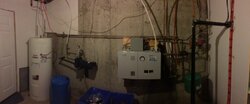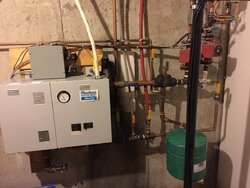Here in Newfoundland we are facing the potential of electricity rates rising by over 50% by 2020 due to the build of the Muskrat Falls hydro station in Labrador. I currently have hydronic heating with an electric boiler, infloor on the main and baseboards in the finished basement. I already balk at the bills I have to pay during the winter months. And here in Newfoundland, winter is a long season.
So to cut my usage I am looking at installing an outdoor wood boiler, something like the P&M 28-40 or the Optimizer 250. My house is a log a frame ~ 2400 square feet. I also have a separate 700 square foot garage that I will add to the system. I will also heat DHW with the boiler.
The in-floor heating is installed poorly I've discovered when investigation a leak from the kitchen drain. It's hung on the joists, only using reflective material below. I have some heat transfer plates on the way and will slowly get them installed correctly, room by room from the basement using adequate insulation once the plates are up. Even the rim joists are not insulated. Sheesh.
I have done a fair bit of reading over the weekend on various setups and systems. From what I gather I should run the boiler loop 24/7, then when the house calls for heat, it will fire up my current system, without running the electric boiler, using a plate exchanger to transfer heat from the boiler, then continue the line to another plate exchanger on my electric DHW boiler.
In the garage I operate a water to air exchanger with a fan.
All make sense so far?
My questions are mainly about plate exchanger sizes? A 20 plate (5x12?) sounds like plenty for my DHW needs. What about for the hydronic? Will the same do, or is something a littler larger needed?
My other question is about wiring the electric boiler so it runs normally without the heating element firing? Where can I find some details on that?
Below is my current electric boiler setup. I'll have the wood boiler loop come in from the right, attach to a HX in the lower return line of the boiler, then run over to my DHW into a HX, then back out again.
Thanks for any and all help/opinions.
(Aside - I tried signing up at outdoorwoodfurnaceinfo.com but never did receive my confirmation emails for two accounts I tried to setup.)

So to cut my usage I am looking at installing an outdoor wood boiler, something like the P&M 28-40 or the Optimizer 250. My house is a log a frame ~ 2400 square feet. I also have a separate 700 square foot garage that I will add to the system. I will also heat DHW with the boiler.
The in-floor heating is installed poorly I've discovered when investigation a leak from the kitchen drain. It's hung on the joists, only using reflective material below. I have some heat transfer plates on the way and will slowly get them installed correctly, room by room from the basement using adequate insulation once the plates are up. Even the rim joists are not insulated. Sheesh.
I have done a fair bit of reading over the weekend on various setups and systems. From what I gather I should run the boiler loop 24/7, then when the house calls for heat, it will fire up my current system, without running the electric boiler, using a plate exchanger to transfer heat from the boiler, then continue the line to another plate exchanger on my electric DHW boiler.
In the garage I operate a water to air exchanger with a fan.
All make sense so far?
My questions are mainly about plate exchanger sizes? A 20 plate (5x12?) sounds like plenty for my DHW needs. What about for the hydronic? Will the same do, or is something a littler larger needed?
My other question is about wiring the electric boiler so it runs normally without the heating element firing? Where can I find some details on that?
Below is my current electric boiler setup. I'll have the wood boiler loop come in from the right, attach to a HX in the lower return line of the boiler, then run over to my DHW into a HX, then back out again.
Thanks for any and all help/opinions.
(Aside - I tried signing up at outdoorwoodfurnaceinfo.com but never did receive my confirmation emails for two accounts I tried to setup.)

Last edited:



